【公开课学案】俳句赏析-In-a-Station-of-the-Metro《在地铁站》学案
In a Station of the Metro 巴黎地铁站
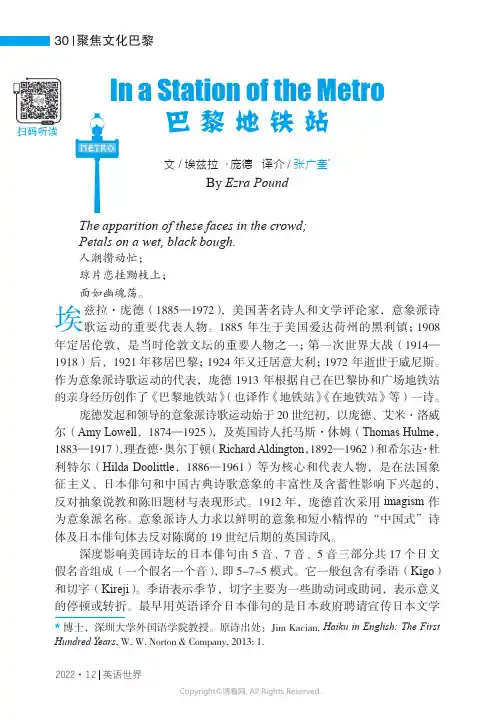
The apparition of these faces in the crowd; Petals on a wet, black bough. 人潮攒动忙;琼片恋挂黝枝上;面如幽魂荡。
埃兹拉·庞德(1885—1972)歌运动的重要代表人物。
1885 年定居伦敦,是当时伦敦文坛的重要人物之一;1918)后,1921作为意象派诗歌运动的代表,庞德 1913 年根据自己在巴黎协和广场地铁站的亲身经历创作了《巴黎地铁站》庞德发起和领导的意象派诗歌运动始于尔(Amy Lowell 1883—1917)、利特尔(Hilda Doolittle 征主义、日本俳句和中国古典诗歌意象的丰富性及含蓄性影响下兴起的,反对抽象说教和陈旧题材与表现形式。
1912In a Station of the Metro 扫码听读
英语世界2022·12。
中英意象派诗歌翻译对比研究——以In a Station of the Metro和《天净沙·秋思》翻译为例
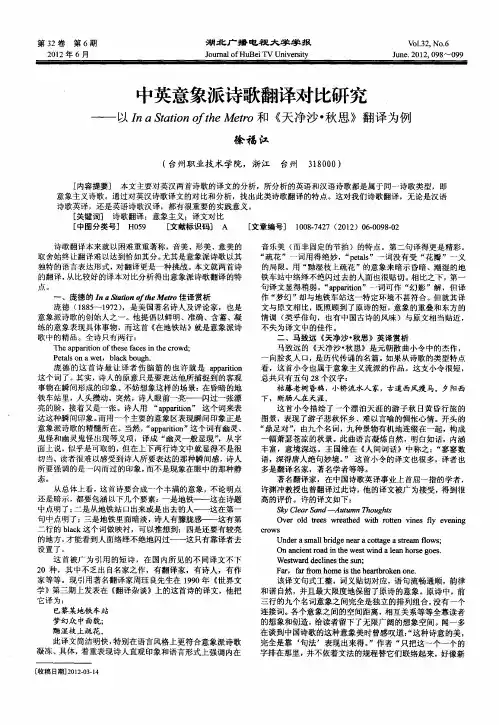
句译文显得稍弱 。“ p a t n ap ri ”一词可作 “ io 幻影 ”解 ,但译 作“ 梦幻 ”却与地铁车站这一特定环境不甚符合 。 就其译 但 文与原文相 比,既照顾到了原诗的短,意象 的重叠和东方 的 情调 ( 乎俳 句,也有 中国古诗 的风 味)与原文相 当贴近 , 类 不失为译文中的佳作。 二、马致远 《 天净 沙・ 秋思》英译赏析 马致远的 《 天净沙・ 思》是元朝 散 曲小令 中的杰作 , 秋 向脍炙人 口,是历代 传诵 的名 篇。如果从诗歌的类 型特 点 看,这首小令也属于意象主义流 派的作 品。这支 小令很 短, 总共 只有 五旬 2 8个汉字 : 枯藤 老树 昏鸦,小桥流水人 家,古道西风瘦马。夕 阳西 下,断肠人在 天涯。 这首小令描 绘 了一个 漂泊天涯 的游子秋 日黄 昏行旅 的 图景,表现 了游子悲秋怀乡 、难 以言喻的惆怅心情。开头的 “ 鼎足对 ” ,由九个名词 ,九种景物有机地连缀在一起,构成 幅萧瑟苍凉 的秋景 。此 曲语言凝炼 自然 ,明 自如话,内涵 丰富,意境深远。王国维在 《 人间词话》中称之 :“ 寥寥数 语,深得唐人绝句妙境 。 这首小令的译文也很多,译者 也 ” 多是翻译 名家 ,著名学者等等 。 著名 翻译家 ,在 中国诗歌英译事业上首届一指 的学者 , 许渊冲教授也 曾翻译过此诗 , 的译文被广为接受 ,得到很 他 高的评价 。p aiin o t e e f c s nt ec o ; e a p rt f h s a e r wd o i h P t l o t b a k b u h e as n awe , lc o g .
庞 德 的这 首诗 最让译 者伤 脑筋 的也许就 是 apr in p aio t 这 个 词 了 。 实 ,诗 人 的 原 意 只 是 要表 达 他 所 捕 捉 到 的客 观 其 事物在 瞬间形成 的印象 。不妨想象这样 的场景 :在昏暗的地 铁 车站里 ,人头攒动 。突然 ,诗人 眼前一亮—— 闪过~张漂 亮 的脸 ,接着 又是一张 。诗人用 “ p a t n 这个 词来表 apri ” io 达这种瞬 问印象 。 而用一个主要的意象 区表现瞬 间印象正是 意象派诗歌 的精髓所在 。当然 , apr i ”这个词有幽灵、 “ p aio tn 鬼怪和 幽灵鬼怪 出现 等义项,译成 “ 幽灵一般显现 ” ,从字 面上说 , 似乎 是可取 的,但在上下两行 诗文 中就 显得 不是很 切 当。 者很难 以感受 到诗人所要表达 的那种瞬 间感 , 读 诗人 所要强调 的是一 闪而过 的印象 , 不是现象在眼 中的那种静 而 态。 从 总体 上 看 , 首 诗 要 合 成 一 个 丰 满 的意 象 , 论 明 点 这 不 还是暗示 ,都要包涵 以下几个要素 :一是地铁——这在诗题 中点明了; 二是从地铁站 口出来或 是出去 的人——这在第一 句 中点 明了; 三是地铁里面 暗淡 ,诗人有艨胧感——这有第
日本的俳句鉴赏赏析
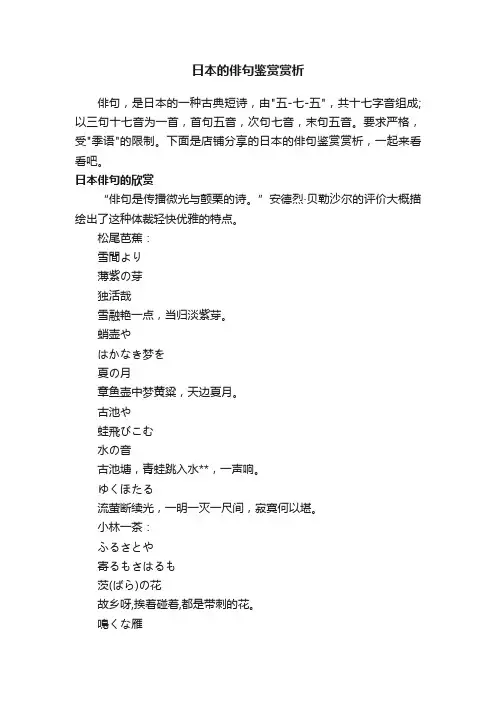
日本的俳句鉴赏赏析俳句,是日本的一种古典短诗,由"五-七-五",共十七字音组成;以三句十七音为一首,首句五音,次句七音,末句五音。
要求严格,受"季语"的限制。
下面是店铺分享的日本的俳句鉴赏赏析,一起来看看吧。
日本俳句的欣赏“俳句是传播微光与颤栗的诗。
”安德烈·贝勒沙尔的评价大概描绘出了这种体裁轻快优雅的特点。
松尾芭蕉:雪間より薄紫の芽独活哉雪融艳一点,当归淡紫芽。
蛸壶やはかなき梦を夏の月章鱼壶中梦黄粱,天边夏月。
古池や蛙飛びこむ水の音古池塘,青蛙跳入水**,一声响。
ゆくほたる流萤断续光,一明一灭一尺间,寂寞何以堪。
小林一茶:ふるさとや寄るもさはるも茨(ばら)の花故乡呀,挨着碰着,都是带刺的花。
鳴くな雁今日から我も旅人ぞ雁别叫了,从今天起,我也是漂泊者啊!日本俳句的来源它源于日本的连歌及俳谐两种诗歌形式。
同时在中国以每日小诗的形式发展。
俳句,是日本的一种古典短诗,由"五-七-五",共十七字音组成;以三句十七音为一首,首句五音,次句七音,末句五音。
要求严格,受"季语"的限制。
它源于日本的连歌及俳谐两种诗歌形式。
同时在中国以每日小诗的形式发展。
我国作家艾芜就曾在《地貌的青春》中写道:"脑海中涌起了诗意画意的涟漪,也就自然地记起日本诗人的俳句和短歌。
"日本俳句的格式俳句是一种有特定格式的诗歌。
俳句的创作必须遵循两个基本规则:第一俳句由五、七、五三行十七个字母组成,当然了,这是以日文为标准的。
第二俳句中必定要有一个季语。
所谓季语是指用以表示春、夏、秋、冬及新年的季节用语。
在季语中除"夏季的骤雨"、"雪"等表现气候的用语外,还有像"樱花"、"蝉"等动物、植物名称。
另外,如"压岁钱"、"阳春面"这样的风俗**惯也多有应用。
In_a_Station_of_the_Metro赏析
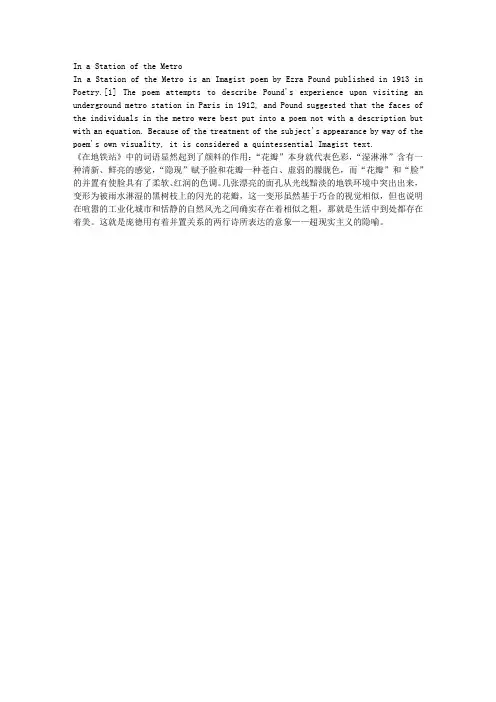
In a Station of the Metro
In a Station of the Metro is an Imagist poem by Ezra Pound published in 1913 in Poetry.[1] The poem attempts to describe Pound's experience upon visiting an underground metro station in Paris in 1912, and Pound suggested that the faces of the individuals in the metro were best put into a poem not with a description but with an equation. Because of the treatment of the subject's appearance by way of the poem's own visuality, it is considered a quintessential Imagist text.
《在地铁站》中的词语显然起到了颜料的作用:“花瓣”本身就代表色彩,“湿淋淋”含有一种清新、鲜亮的感觉,“隐现”赋予脸和花瓣一种苍白、虚弱的朦胧色,而“花瓣”和“脸”的并置有使脸具有了柔软、红润的色调。
几张漂亮的面孔从光线黯淡的地铁环境中突出出来,变形为被雨水淋湿的黑树枝上的闪光的花瓣,这一变形虽然基于巧合的视觉相似,但也说明在喧嚣的工业化城市和恬静的自然风光之间确实存在着相似之粗,那就是生活中到处都存在着美。
这就是庞德用有着并置关系的两行诗所表达的意象——超现实主义的隐喻。
in a station of the metro赏析
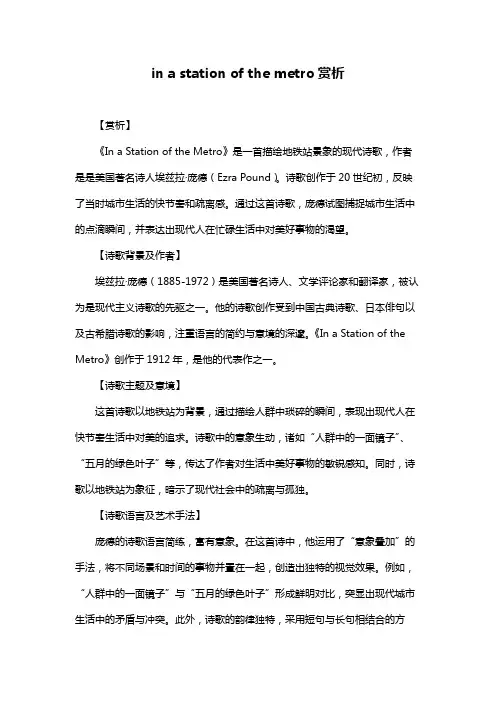
in a station of the metro赏析【赏析】《In a Station of the Metro》是一首描绘地铁站景象的现代诗歌,作者是是美国著名诗人埃兹拉·庞德(Ezra Pound)。
诗歌创作于20世纪初,反映了当时城市生活的快节奏和疏离感。
通过这首诗歌,庞德试图捕捉城市生活中的点滴瞬间,并表达出现代人在忙碌生活中对美好事物的渴望。
【诗歌背景及作者】埃兹拉·庞德(1885-1972)是美国著名诗人、文学评论家和翻译家,被认为是现代主义诗歌的先驱之一。
他的诗歌创作受到中国古典诗歌、日本俳句以及古希腊诗歌的影响,注重语言的简约与意境的深邃。
《In a Station of the Metro》创作于1912年,是他的代表作之一。
【诗歌主题及意境】这首诗歌以地铁站为背景,通过描绘人群中琐碎的瞬间,表现出现代人在快节奏生活中对美的追求。
诗歌中的意象生动,诸如“人群中的一面镜子”、“五月的绿色叶子”等,传达了作者对生活中美好事物的敏锐感知。
同时,诗歌以地铁站为象征,暗示了现代社会中的疏离与孤独。
【诗歌语言及艺术手法】庞德的诗歌语言简练,富有意象。
在这首诗中,他运用了“意象叠加”的手法,将不同场景和时间的事物并置在一起,创造出独特的视觉效果。
例如,“人群中的一面镜子”与“五月的绿色叶子”形成鲜明对比,突显出现代城市生活中的矛盾与冲突。
此外,诗歌的韵律独特,采用短句与长句相结合的方式,呈现出地铁站拥挤与繁忙的氛围。
【诗歌的价值和启示】《In a Station of the Metro》以独特的视角审视了现代城市生活,为我们提供了一个思考城市人与自然、快节奏与宁静之间关系的窗口。
诗歌传达了作者对美好生活的向往,提醒人们在忙碌的生活中关注身边的美好事物。
同时,这首诗歌也是现代主义诗歌的代表之作,对后世诗人产生了深远影响。
通过分析这首诗歌,我们可以看到庞德在诗歌创作中的独特艺术手法和审美观念。
庞德In a Station of the Metro赏析
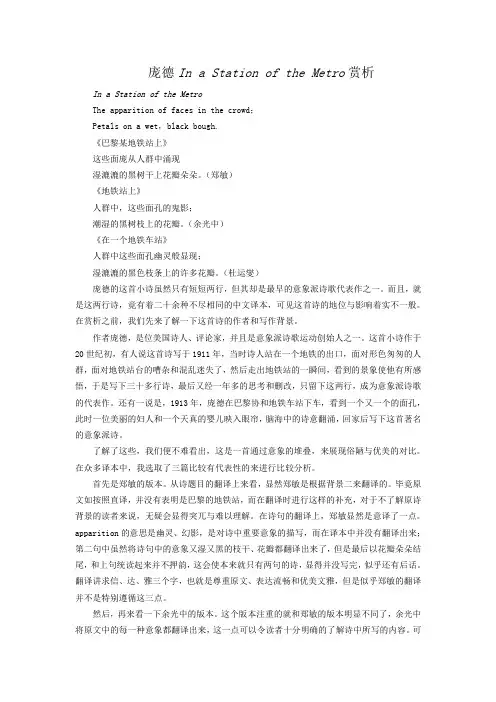
庞德In a Station of the Metro赏析In a Station of the MetroThe apparition of faces in the crowd;Petals on a wet,black bough.《巴黎某地铁站上》这些面庞从人群中涌现湿漉漉的黑树干上花瓣朵朵。
(郑敏)《地铁站上》人群中,这些面孔的鬼影;潮湿的黑树枝上的花瓣。
(余光中)《在一个地铁车站》人群中这些面孔幽灵般显现;湿漉漉的黑色枝条上的许多花瓣。
(杜运燮)庞德的这首小诗虽然只有短短两行,但其却是最早的意象派诗歌代表作之一。
而且,就是这两行诗,竟有着二十余种不尽相同的中文译本,可见这首诗的地位与影响着实不一般。
在赏析之前,我们先来了解一下这首诗的作者和写作背景。
作者庞德,是位美国诗人、评论家,并且是意象派诗歌运动创始人之一。
这首小诗作于20世纪初,有人说这首诗写于1911年,当时诗人站在一个地铁的出口,面对形色匆匆的人群,面对地铁站台的嘈杂和混乱迷失了,然后走出地铁站的一瞬间,看到的景象使他有所感悟,于是写下三十多行诗,最后又经一年多的思考和删改,只留下这两行,成为意象派诗歌的代表作。
还有一说是,1913年,庞德在巴黎协和地铁车站下车,看到一个又一个的面孔,此时一位美丽的妇人和一个天真的婴儿映入眼帘,脑海中的诗意翻涌,回家后写下这首著名的意象派诗。
了解了这些,我们便不难看出,这是一首通过意象的堆叠,来展现俗陋与优美的对比。
在众多译本中,我选取了三篇比较有代表性的来进行比较分析。
首先是郑敏的版本。
从诗题目的翻译上来看,显然郑敏是根据背景二来翻译的。
毕竟原文如按照直译,并没有表明是巴黎的地铁站,而在翻译时进行这样的补充,对于不了解原诗背景的读者来说,无疑会显得突兀与难以理解。
在诗句的翻译上,郑敏显然是意译了一点。
apparition的意思是幽灵、幻影,是对诗中重要意象的描写,而在译本中并没有翻译出来;第二句中虽然将诗句中的意象又湿又黑的枝干、花瓣都翻译出来了,但是最后以花瓣朵朵结尾,和上句统读起来并不押韵,这会使本来就只有两句的诗,显得并没写完,似乎还有后话。
【公开课学案】俳句赏析-In-a-Station-of-the-Metro《在地铁站》学案
【公开课学案】俳句赏析-In-a-Station-of-the-Metro《在地铁站》学案俳句赏析: In a Station of the Metro《在地铁站》导学案Step 1 Review and Lead-in1.What are the features of Haiku?2.Enjoy some more Haiku(1) First autumn morningThe mirror I stare intoShows my father’s face.---Kijo Murakami初秋的早晨,我凝视镜中,镜中浮现出父亲的脸。
(村上鬼村)(2) The snow is meltingAnd the village is floodedWith happy children.---Kobayash iIssa雪化了,小屁孩们像洪水一样,出现在村子里。
(小林一茶)(3) Pleasure in cellphonesRuin the soul of all studentsA black Datura.(4) A black running carFar ahead from starting lineNow he is coming.3. Introduction of Ezra Pound and “In a Station of the Metro”Step 2 Jigsaw reading (拼图阅读)1. Combine these four parts to make a new poem.of these faces in the crowdon a wet, black boughpetalsthe apparitionV ocabulary: petal:(图例)花瓣bough:(图例)大树枝apparition: the act of appearing; flashing2. Enjoy students’ ver sionsStep 4. Enjoy Pound’s versionIn a Station of the MetroThe apparition of these faces in the crowd;Petals on a wet, black bough.Step 4 Read the lines1. Put the poem into Chinese2. Different translations of the poems & different understandin g of “apparition”.“显现”, “浮现”, “闪现”, “惊现”3. Analyze the source of Pound’s inspiration.Step 5 Read between the lines1. What are the four images in the poem?2. What are the real images and what are imaginary ones?3. Discussion:Why does Pound compare “faces” to “petals”?Shape:Color:Feelings:Movements:4. What are the writing skills employed by the poet?5.What is the theme of the poem?Step 6 Mirror Writing & Show TimeStep 7 Assignment1. Recommended readingWhen You Are Old by Yeats(叶芝《当你老了》)The Road Not Taken by Robert Frost (罗伯特·弗罗斯特《未选择的路》)A Grain of Sand by William Blake(威廉.布莱克《一粒沙子》)2. Polish the haiku you've written and hand it in tomorrow.。
诗歌赏析 Appreciation of the Poem In a Station of the Metro教学内容
诗歌赏析A p p r e c i a t i o n o f t h e P o e m I n a S t a t i o n o f t h eM e t r oAppreciation of the Poem In a Station of the Metro学号:11211010425 姓名:张欣慧In a Station of the MetroThe apparition of these faces in the crowd;Petals on a wet, black bough.In a Station of the Metro is an imagist poem by Ezra Pound published in 1913 in Poetry.The author Ezra Pound, was an American poet, critic, and he is one of the founders of imagist poetry movement. This little poem, although only two lines, but it is one of the earliest imagist poetry masterpiece. And, this is the two lines of poetry, and has more than 20 kinds of different Chinese version.This poem attempts to describe Pound's experience upon visiting an underground metro station in Paris in 1912, and Pound suggested that the faces of the individuals in the metro were best put into a poem not with a description but with an equation. Because of the treatment of the subject's appearance by way of the poem's own visuality, it is considered a quintessential Imagist text.In the poetry of In a Station of the Metro,one of the most impressive characteristics of artistic expression is image superposition characterized by intuitiveness which links metaphor and images together to produce a variety of special and unique artistic effect. In the poetry of In a Station of the Metro,the image of “apparition of faces” in the first line echoes to “petals on a bough” in the second line. Such kind of image superposition contains profound thoughts and leaves us an unmeasured mental space to imagine the information and emotion hidden in this poetry.These two sets of images in front of us have describes such a picture like: After a heavy rain, the sky was gloomy and grey, the air was humid and filled with the smellof material decadence. A dark and wet subway station was standing in a corner of the city. People in this station were crowd and silent, moving mechanically without any communications with others. Some of them seemed to be alert, some seemed to cunning and some seemed to be indifferent with everything, without any face expression. Suddenly, there appeared innocent faces of children as good as petals, they were hand in hand with each other and sing along with their songs…The poet was pleasantly surprised and refreshed by these faces.And in this poetry, there are two lines with all together fourteen words and except for the words like: in, these, of, a, the, on, there are mainly five nouns and two adjectives. It produces four images with two images in the first line and another two in the second line.In the first line, there are the two images: “face” and “crowd”. “Face” is the carrier of “apparition”, and it is the bright spot in the crowded subway station. The “face” under the foil of “apparition” looks like the lotus in the mud. And the second image is the “crowd” which presents the scene of the poetry----subway station. In this crowded station where people comes and goes in a hurry, the only one thing caught poet’s eyes was the faces of the beauty who appeared unimaginably and disappeared hastily. That’s why the author called them “apparition”, since they are so beautiful that the poet cannot believe and disappear so quickly that the port cannot grasp in time.In the second line, there are another two images, “petals” and “bough”. Ezra Pound resembled “petals” to the “faces” of the young and children that appeared in the dark and wet subway station. And like the relations between “petals” and “faces”, “bough” also echoes to the image of “crowd” which serves as a foil to “petals”. And there are two adjectives used to mollify “bough”, they are “black” and “wet”. Because of the close relations between “bough” and “crowd”, the two adjectives “black” and “wet” not only belongs to the image of “bough”, but also mollify the image of “crowd” while “wet” demonstrates the face of sweats or glittering eyes of the beauty; and “black” demonstrates the darkness in the station and the gloomy of people.Ezra Pound is one of the founders of imagism and puts forward three principlesof imagist poetry. And In a Station of the Metro is one of his masterpieces in imagist poems which clearly and skillfully presents the first principle of describing and presenting things directly and concisely.Obviously, it is the traffic hub of a city that can best demonstrate the modern civil culture in it. Thus, the image of city would better be presented by the subway station. Since, over there, you can witness the ups and downs of people and imagine the prosperity and poverty of the city; And under the severe destruction of industrial civilization, only plants growing in natural environment can better demonstrate the passed good industrial civilization. Thus, the “petals” on the “bough” must be the best image of the good things produced by industrial society. It is these two totally different sets of images that provide us with direct access to understand the feelings of Ezra Pound towards western industrial country.We can understand it from two different ways. On the one hand, “petals” not grow on green branched but on the wet black “bough”. It forms an obvious contrast between the beauty of “petals” and the black of “bough”, which makes the “petals” looks more beautiful and the black “bough” much more ugly and disgusting. Form this point, we can imagine that poet hates the luxury, materialistic inflation, and indifference which deeply rooted at city life, and eagers to pursue the good things which are full of hope and optimism. On the other hand, on the black wet “bough”, there appeared beautiful “petals”, and in humi d and gloomy environment, there appeared glittering “faces” of beauty. The “apparition of faces” and “petals on the bough” supports each other and adds to each other’s connotation of image. Form this point, and think together with our usual lives, it would not be difficult for us to find the philosophy contained in it: The darkness in society is coincided with the brightness; and the ugliness is also coincided with beauty to exist in the world; and the dilemma must coincided with hopes and chances. Thus, do not loose your heart and never give up once you are trapped in troubles and feel depressed; and do keep your awareness of unexpected sufferings when your are living in a harmonious life.What’s more, we can find that the images in the poetry of In a Station of the Metro are “still and silent”. Like “faces” and “crowd”, “petals” and “bough”. Thereare no verbal words in this poetry while every noun represents a piece of picture and appears one by one to make up a visual feast for readers. And it would not be difficult for us to find that the descriptions of the images in this poetry are both subjective and objective. Like “faces” and “petals”, “crowds” and “bough”, the former is subjective and the latter is objective. Ezra Pound uses both objective statements and subjective imaginations to deliver his own opinions and emotions. Lastly, we need to know that the images we’ve found in this poetry are such a kind of mental images. Both “petals” and “bough” are mental images in poet’s heart. They are the imaginati ons of the “faces” appeared in the subway station which are not real. Such kind of mental images are produced in moments when poet finally obtain spirits and put them into the internal mind after careful observation and imaginative contemplation.The poem of In a Station of the Metro is not only a great masterpiece among Ezra Pound’s imagistic poems, but also stands for a landmark in the creation of imagistic poems in history of the world.。
【公开课课件】选修六Unit-2-俳句赏析
雪化了, 小屁孩们像洪水一样, 出现在村子里。 日本小林一茶著
5 7 5
Pleasure in cellphones Ruin the soul of all students A black Datura.
曼陀罗 [də'tjʊərə] - Miss Zeng
A black running car Far ahead from starting line Now he is coming.
俳句赏析:
“In a Station of the Metro” 《在地铁站》
秋落 水霞 共与 长孤 天鹜 一齐 色飞
• 哇!好大一只鸟,真好看,真**太好看了!
Step 1 Review & Lead in
Haiku
First autumn morning The mirror I stare into Shows my father’s face. -Kijo Murakami
• What does the apparition mean? One is “suddenly appear”and the other is “something like ghost”.this word nicely captuers the immediate impression left on the poet’s mind and the powerful emotional impact he felt in that situation. We can easily touch that the faces in the subway are depressed.
In a Station of the Metro The apparition of these faces in the crowd; Petals on a wet,black bough.
_地铁车站_之意象主义赏析
泛。关于地铁, 英式英语更倾向于使用
摘要
“Underground”, 而 美 式 英 语 则 往 往 称
道 。“Metro”一词 在 英 语中 虽 然 也能 表 七 大 学 外 语 学 院 博 士 生 , 研 究 方 向 : 英
达地铁的意思, 然而它的使用并不广 语语言文学。
060
作家杂志 Write r Ma ga zine 2008 No.8
《地铁车站》之意象主义赏析 吴 攸
借鉴与比较
庞 德 的 代 表 作 《地 铁 车 站》( In a Station of the Metro) 是 意 象 派 诗 歌 的 压 卷之作, 诗歌仿日本俳句风格而作。庞 德 曾 在 1916 年 写 道 :“ 三 年 前 的 巴 黎 , 我 走 出 协 和 广 场( la Concorde) 地 铁 站 。 突然间, 我看到了一张美丽的面庞, 接 着是一张又一张, 我又看到一张美丽 的儿童面孔, 然后又是一个美丽的女 人。那一整天, 我努力寻找恰当的文字 来表达那种突然迸发的情感与感受, 然而却未能如愿。那天晚上, 当我仍然 在继续努力寻找的时候, 忽然间一种 表达方式闯进了我的脑海。与其说我 找到了一些文字, 不如说是发现了一 个方程式……不是用语言……而是一 个叠加形式, 即一个意向叠加在另一 个意向之上。”
意 象 。在 短 短 两 行 诗 句 构 成 的 诗 歌 中 , 我们不得不赞扬庞德对标点符号的准 确把握与运用。诗人在长达一年的去 芜存菁过程中, 用分号替代了原本置 于第一行末尾的冒号。这一改变使得 两行诗句之间更具微妙联系。原来的 冒号似乎从主观上限定了第一行诗句 的从属地位, 意即第一行本身并非完 整的诗句, 其作用只不过是为了引出 第二行的意向。改为分号之后, 第一行 诗句的从属性减弱, 而两行诗句之间 的关系更加微妙, 甚至有些模糊不清, 带给读者更大的遐想空间, 也大大提 升了诗歌的意境。
- 1、下载文档前请自行甄别文档内容的完整性,平台不提供额外的编辑、内容补充、找答案等附加服务。
- 2、"仅部分预览"的文档,不可在线预览部分如存在完整性等问题,可反馈申请退款(可完整预览的文档不适用该条件!)。
- 3、如文档侵犯您的权益,请联系客服反馈,我们会尽快为您处理(人工客服工作时间:9:00-18:30)。
俳句赏析: In a Station of the Metro《在地铁站》
导学案
Step 1 Review and Lead-in
1.What are the features of Haiku?
2.Enjoy some more Haiku
(1) First autumn morning
The mirror I stare into
Shows my father’s face.
---Kijo Murakami
初秋的早晨,
我凝视镜中,
镜中浮现出父亲的脸。
(村上鬼村)
(2) The snow is melting
And the village is flooded
With happy children.
---Kobayash iIssa
雪化了,
小屁孩们像洪水一样,
出现在村子里。
(小林一茶)
(3) Pleasure in cellphones
Ruin the soul of all students
A black Datura.
(4) A black running car
Far ahead from starting line
Now he is coming.
3. Introduction of Ezra Pound and “In a Station of the Metro”
Step 2 Jigsaw reading (拼图阅读)
1. Combine these four parts to make a new poem.
of these faces in the crowd
on a wet, black bough
petals
the apparition
V ocabulary: petal:(图例)花瓣
bough:(图例)大树枝
apparition: the act of appearing; flashing
2. Enjoy students’ ver sions
Step 4. Enjoy Pound’s version
In a Station of the Metro
The apparition of these faces in the crowd;
Petals on a wet, black bough.
Step 4 Read the lines
1. Put the poem into Chinese
2. Different translations of the poems & different understandin g of “apparition”.“显现”, “浮现”, “闪现”, “惊现”
3. Analyze the source of Pound’s inspiration.
Step 5 Read between the lines
1. What are the four images in the poem?
2. What are the real images and what are imaginary ones?
3. Discussion:
Why does Pound compare “faces” to “petals”?
Shape:
Color:
Feelings:
Movements:
4. What are the writing skills employed by the poet?
5.What is the theme of the poem?
Step 6 Mirror Writing & Show Time
Step 7 Assignment
1. Recommended reading
When You Are Old by Yeats(叶芝《当你老了》)
The Road Not Taken by Robert Frost (罗伯特·弗罗斯特《未选择的路》)
A Grain of Sand by William Blake(威廉.布莱克《一粒沙子》)
2. Polish the haiku you've written and hand it in tomorrow.。
